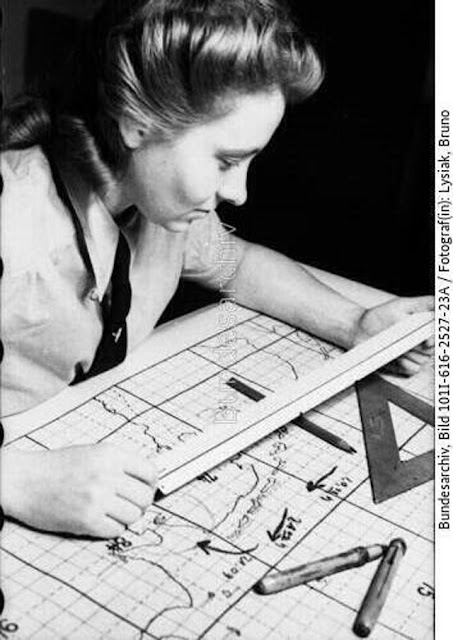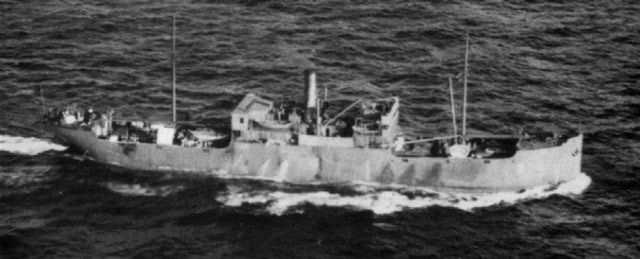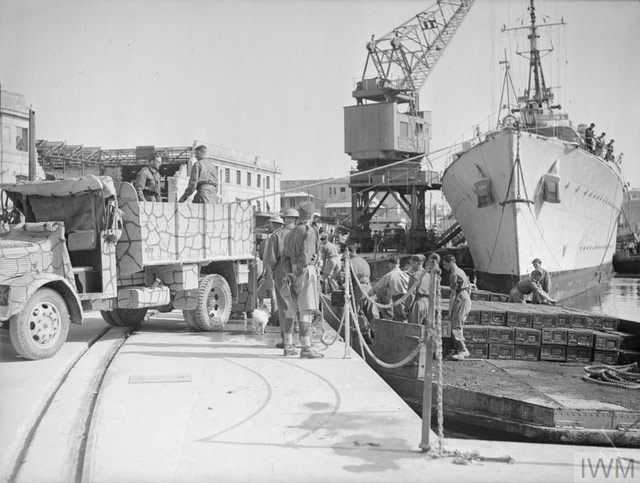Sunday 10 May 1942
 |
| Curtiss SOC-3A of VGS-1 parked on the flight deck of escort carrier USS Long Island (AVG-1), 10 May 1942 (Naval History and Heritage Command 80-G-14521). |
Battle of the Pacific: USAAF B-25 and B-26 bombers based in Port Moresby attack the new Japanese seaplane base at the Deboyne Islands on 10 May 1942 for the second day in a row, losing one of each type of bomber. The Japanese seaplane tender Kamikawa Maru is badly damaged and departs for repairs. Without the tender, the base is difficult to sustain. Thus, the Japanese begin evacuating the Deboyne base today due to its vulnerability and the failure of Operation Mo to invade Port Moresby. However, the seaplanes based there remain operational and spend the morning searching for Admiral Frank Jack Fletcher's Task Force 17 (USS Yorktown) without success. B-17 bombers also bomb the port of Kessa, Buka, in the Northern Solomon Islands.
Rear Admiral Fletcher already has departed the area, taking TF 17 south of New Caledonia. At 01:00, Australian Rear Admiral John Crace, commanding TF 44, also orders his cruisers back to Australia after losing communication with Fletcher. Unable to find the Allied carrier fleet, Vice Admiral Takeo Takagi takes most of his fleet back to Rabaul and sends his remaining aircraft carrier, Zuikaku, back to Japan to replenish its air units.
The Japanese, as a follow-up to their intricate Operation Mo, have planned to invade Nauru and Ocean Island. This is Operation Ry. The ships assigned to this operation are planning to set out, but the failure of Operation Mo makes this a much riskier proposition. Takagi is to command a critical component of this operation, too, though his 5th Cruiser Division will have no carrier support.
 |
| Kualoa Airfield, Oahu, Hawaii, 10 May 1942. |
Major General Jonathan Wainwright officially surrenders to Lieutenant General Masaharu Homma today. This is more symbolic and a formality, as Wainwright has been in captivity for several days and no longer has the authority to order surrenders. However, Major General William Sharp, in command of remaining Allied troops in the Philippines based primarily in Mindanao, decides to follow Wainwright's lead out of fears of a massacre of Wainwright's men if he does not. Right after Wainwright's radio speech, he orders the surrender of all remaining troops. Many of Sharp's Filipino troops decide to join the guerilla forces of Colonel Wendell Fertig instead rather than surrender. Like Wainwright, Sharp ultimately is sent to confinement in Mukden (Shenyang), Manchuria. This marks the end of the Philippine Campaign. The Allies have lost 140,000 lives and there are about 12,500 Allied prisoners of war. They are treated with great brutality.
US Navy submarine USS Silversides (SS-236) is operating 540 miles north of Marcus Island when it gets into a surface battle with Japanese guard boat No. 5 Ebisu Maru. The battle ends in a draw, with the heavily damaged Japanese boat making it back to port and the submarine losing one crewman when it is raked with machine gunfire.
 |
| President Franklin Roosevelt at an early-morning "birding party" near Pine Plains, New York. FDR is a big bird lover and Margaret "Daisy" Suckley, lower right, organized this one on 10 May 1942 (FDR Presidential Library 62-383). |
Battle of the Indian Ocean: A new player enters the war in Burma when the Thai Phayap Army invades Shan State as a Japanese ally. There aren't many Allied troops left there, though, just scattered troops left behind during retreats who cause little trouble to the Axis troops. In western Burma, the British are retreating as fast as they can. Gurkha units are performing rearguard duties before they, too, retreat.
Japanese bombers attack Imphal, India. It is the first attack of the war on Imphal. The Japanese later claim that they were bombing an airfield, but the city has no airfield. At least 70 civilians are killed and another 80 wounded. The local population flees the city after the bombing and does not return for several days.
The Japanese attack the 17th Indian Division, about 10,000 men, at Shwegyin Chaung near the Chindwin River. This forces the 17th Division to withdraw up the Kabaw Valley to the border town of Tamu. The Japanese do not follow and instead fall back on their base.
To cover the retreating Allied forces, the 10th Air Force sends four B-17s to bomb Japanese planes parked at the Myitkyina Airfield. They destroy several planes and cause damage to the runway.
The Japanese have sent some ships in the "A Detachment" into the Indian Ocean for another raid on merchant ships from Penang. The A Detachment includes submarines I-10, I-30, I-16, I-18, and I-20, as well as tender Nisshin. Among the objectives is to reconnoiter the East African coast for potential invasion location. Some of the submarines carry reconnaissance planes, others Kai 1 (tiny) submarines. Today, the A Detachment refuels at sea from tankers Aikoku Maru and Hokoku Maru.
Illustrating the global nature of the conflict, aircraft carrier USS Ranger launches 60 P-40 Warhawk fighters off the African Gold Coast. The planes fly to Accra and then on to Karachi, India, where they are to join the 10th Air Force for operations out of India.
 |
| Soviet POWs stacking bales of hay for the Germans, May 1942 (Schürer, Federal Archive Image 183-B19683). |
Eastern Front: General Franz Halder, who generally takes a cautious or even pessimistic view of developments of the front, writes in his war diary: "The Kerch offensive, which was going on so well, has been slowed down by adverse weather. Other fronts quiet." The Kerch Offensive he's referring to is Operation Trappenjagd.
The truth isn't quite so miserable for the German cause as Halder implies. Luftwaffe Fliegerkorps VIII greets the morning, during which light rain continues drizzling down until noontime, by attacking Soviet tanks desperately trying to stop the German breakthrough. This includes 11 KV-1 tanks, which are heavily armored but slow and ponderous. Another part of Fliegerkorps VIII, KG 55, sends its Heinkel He 111 bombers to attack the infantry. While 8 of the slow bombers are shot down, they drop enough anti-personnel bombs (SD-2) to decapitate the forward Soviet units. Luftwaffe General Wolfram von Richthtofen sends other bombers to attack the Soviet supply lines from Kerch to the mainland. During these attacks, they sink three transport ships carrying 900 wounded, a gunboat, six patrol boats, and assorted other vessels.
The 22nd Panzer Division is held up by the rain and mud and only begins moving during the afternoon. However, after that it makes good time on its drive to the northern coast to trap Soviet 51st Army and almost completes the encirclement by nightfall. General Fretter-Pico's scratch Grodeck Brigade, meanwhile, continues driving east toward Kerch without much opposition and even gets through the second main Soviet line (the Sultanovka, or Turkish Wall, Line). The Soviets had hoped to make a stand at this line by pulling troops back from the front, but the Red Army generals can only engage in recriminations on why this doesn't happen. Fretter-Pico decides late in the day to send the 132nd Infantry Division toward Kerch along the same road the Grodeck Brigade took in the morning even though there are signs the Soviets are attempting to seal that hole in the front.
 |
| A Luftwaffe helper (Luftwaffenhelfer) at a flight control center in France, May 1942 (Lysiak, Bruno, Federal Archive Image 101I-616-2527-23A). |
While the Crimea battle is going badly for it, the Red Army is preparing a major offensive by the Southwestern Front and Southern Front. It is to be aimed at Kharkiv. There are six armies in the two fronts, with hundreds of tanks and masses of artillery. In overall command is Marshal Semyon Timoshenko. His Military Commissar, who technically has equal input into tactical and strategic decisions, is Nikita Khrushchev. The attack, which has been delayed by the spring thaw ("rasputitsa"), is scheduled to begin on 12 May.
The Wehrmacht also is planning an operation centered on Kharkiv. This is Operation Fredericus, which is to be completed by the Sixth Army under the command of General der Panzertruppe Friedrich Paulus. The goal of Operation Fridericus is to blow a hole in the Soviet line south of Kharkiv around the "Izyum Bulge," a projection of the Red Army line formed during the Soviet winter counteroffensive. This, it is hoped, will be the opening stages of "Case Blue," the decisive summer offensive spelled out in Fuhrer Directive No. 41 that is to capture the Caucasus oil fields and finish the Soviet Union as a major power. It is vital to German plans that Operation Fridericus be executed quickly and completely.
The choice of Paulus as commander of both Sixth Army and this critical operation is curious. He is well known to be primarily a staff officer with little battle experience. However, he also is known to be bright and hard-working, and that counts for a lot in the Third Reich. Paulus advanced to this position in January 1942 because he has been a protege of Field Marshal Walther von Reichenau - but Reichenau passed away the same month, leaving little reason for Paulus to fill this key position over other, battle-hardened commanders.
The Army Group South rear areas near Kharkiv are filling up with troops penciled in to serve in Case Blue. In effect, the other army groups are being deprived of troops at the expense of Army Group South. However, Hitler is adamant that these new troops are to be kept in reserve and are not to be used for any purposes other than Case Blue. So, Paulus must complete Operation Fridericus using only Sixth Army. That operation is projected to begin on 18 May. Today, Paulus submits his final draft of Operation Fridericus but warns his superiors that the Soviets may be planning a spoiling attack.
So, both sides are preparing large offensives at the same spot in the southern front, with the Soviets planning to attack first. The Germans have about 300,000 men at the front in this general area, supported by 1000 tanks and 1500 aircraft. However, a great deal of Luftwaffe strength remains fully committed in Crimea for some time.
 |
| Q-ship Evelyn, 10 May 1942 (US Coast Guard). |
European Air Operations: There are no operations by either side, most likely due to inclement weather.
Battle of the Atlantic: U-333 (Kptlt. Peter-Erich Cremer), on its second patrol out of La Pallice, torpedoes and sinks 5214-ton British freighter Clan Skene 300 miles southeast of Cape Hatteras. This is an opportunistic sinking by U-333 because it was damaged by depth charges a few days ago and was limping back to France when it spotted the unescorted freighter. There are nine deaths and 73 survivors, who are picked up by USS McKean (APD 5).
U-506 (Kptlt. Erich Würdemann), on its second patrol out of Lorient, torpedoes and sinks 7050-ton US tanker Aurora about 40 nautical miles from Southwest Pass, Louisiana. There are one death and 38 survivors, who are rescued by USS Onyx and YP-157. Two tugs take the burning tanker in tow to Algiers, Louisiana, and it is eventually repaired and returned to service under the new name Jamestown.
U-588 (Kptlt. Victor Vogel), on its third patrol out of St. Nazaire, torpedoes and sinks 4031-ton UK freighter Kitty's Brook about 35 nautical miles (65 km) east of Cape Sable, Nova Scotia. There are 25 survivors and nine deaths.
German replenishment oiler Warmia hits a mine in the Bay of Biscay and is severely damaged.
 |
| Romanian pioneers celebrate the Day of the King, 10 May 1942. They are carrying Pignone model 1937 flame-throwers. |
Battle of the Mediterranean: Axis spies have told the Germans and Italians in Sicily about the recent arrival of over 60 Spitfire fighters, so they try to eliminate this new force as quickly as possible. The Luftwaffe sends 20 Ju 87 Stukas and 10 Junkers Ju 88s with a heavy escort, followed by another raid by 10 Ju 88s escorted by over 30 Bf 109s. A third raid then comes in by Italian Cant Z1007 bombers escorted by 10 MC 202 and 10 Re 2001 fighters. Finally, a fourth raid by 20 Stukas with Bf 109 escorts takes place. The raids come in quick succession, but they meet heavy fighter opposition. The Spitfire fighters disperse the attacks, shoot down many bombers, and convince the Axis headquarters that daylight raids on Malta are now a very bad idea.
 |
| Spitfires of RAF No. 91 Squadron lined up at RAF Hawkinge, May 1942. |
German 79-ton Schnellboot (E-boat) S-31 hits a mine and sinks in while laying mines off Sliema Point near Grand Harbour, Malta. The mines are intended to sink freighter HMS Welshman, which is carrying ammunition for the island's anti-aircraft guns, ground personnel for the recently arrived Spitfire fighters, and spare aircraft engines, among other things. Welshman gets in and out of the harbor by nightfall without damage. It is likely that S-31 hits one of the mines it had just laid that accidentally got cut from its moorings. There are 13 deaths and 13 survivors, including skipper Lt. Heinrich Haag.
 |
| HMS Welshman at the dock in Malta, 10 May 1942. © IWM A 9507. |
Battle of the Black Sea: The Luftwaffe bombs and sinks 1048-ton Soviet transport Chernomorets during a voyage from Kerch to Novorossiysk. There over 500 deaths, many of them wounded men being repatriated.
War Crimes: The Luftwaffe raids Alexandria, bombing and sinking British hospital ship Ramb IV (formerly an Italian ship but captured at the port of Massawa on 10 April 1941). There are 165 deaths, 155 of them wounded soldiers. There are always excuses for bombing hospital ships in the fog of war, but they are clearly marked. Doing so is a recognized war crime.
US Military: The US Navy holds a demonstration of towing fighter planes behind a larger aircraft in order to increase their range at the Naval Aircraft Factory in Philadelphia, Pennsylvania. A twin-engined Douglas BD A-20 successfully tows two Grumman F4F Wildcat fighters for an hour at 180 knots at 7000 feet. Despite the success of the demonstration, the idea does not catch on.
President Roosevelt authorizes the Air Medal to recognize meritorious achievements while flying.
 |
| Civilian Exclusion Order No. 61, issued 10 May 1942. |
British Homefront: Winston Churchill gives a radio address on the second anniversary of his having replaced Neville Chamberlain as Prime Minister. He specifically warns Hitler about using poison gas, saying:
we shall treat the unprovoked use of poison gas against our Russian ally exactly as if it were used against ourselves and if we are satisfied that this new outrage has been committed by Hitler we will use our great and growing air superiority in the West to carry gas warfare on the largest possible scale far and wide against military objectives in Germany.
Churchill does not mention that both sides are developing poison gas and have been for some time. Hitler has shown no indication that he intends to use it against England, though there is evidence Germany is using it in certain instances on the Eastern Front (and in concentration camps, of course). Canada established the Suffield Field Experimental Station in Alberta in 1941 to develop and test poison gas. Beginning around this time, the Canadian government gasses about 2000 people, including many without full protective gear. Many sustain injuries, especially around the eyes.
American Homefront: The Western Defense Command issues Civilian Exclusion Orders No. 60 and No. 61. They require every individual or family with full or partial Japanese ancestry to register at a Civil Control Station within 24 to 48 hours.
It is Mother's Day. Knott's Berry Farm sells a record 6,390 1/2 chicken dinners during the day. The demand for chicken dinners is so strong that the restaurant runs out of chickens by 17:00, with some guests waiting as long as four hours for their chicken.
President Roosevelt spends a quiet day at Hyde Park, New York, without any appointments.
No comments:
Post a Comment